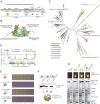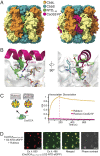Identification of a carbonic anhydrase-Rubisco complex within the alpha-carboxysome
- PMID: 37862384
- PMCID: PMC10614612
- DOI: 10.1073/pnas.2308600120
Identification of a carbonic anhydrase-Rubisco complex within the alpha-carboxysome
Abstract
Carboxysomes are proteinaceous organelles that encapsulate key enzymes of CO2 fixation-Rubisco and carbonic anhydrase-and are the centerpiece of the bacterial CO2 concentrating mechanism (CCM). In the CCM, actively accumulated cytosolic bicarbonate diffuses into the carboxysome and is converted to CO2 by carbonic anhydrase, producing a high CO2 concentration near Rubisco and ensuring efficient carboxylation. Self-assembly of the α-carboxysome is orchestrated by the intrinsically disordered scaffolding protein, CsoS2, which interacts with both Rubisco and carboxysomal shell proteins, but it is unknown how the carbonic anhydrase, CsoSCA, is incorporated into the α-carboxysome. Here, we present the structural basis of carbonic anhydrase encapsulation into α-carboxysomes from Halothiobacillus neapolitanus. We find that CsoSCA interacts directly with Rubisco via an intrinsically disordered N-terminal domain. A 1.98 Å single-particle cryoelectron microscopy structure of Rubisco in complex with this peptide reveals that CsoSCA binding is predominantly mediated by a network of hydrogen bonds. CsoSCA's binding site overlaps with that of CsoS2, but the two proteins utilize substantially different motifs and modes of binding, revealing a plasticity of the Rubisco binding site. Our results advance the understanding of carboxysome biogenesis and highlight the importance of Rubisco, not only as an enzyme but also as a central hub for mediating assembly through protein interactions.
Keywords: CO2 fixation; carbonic anhydrase; carboxysome; cryoelectron microscopy; protein–protein interactions.
Conflict of interest statement
The authors declare no competing interest.
Figures





Comment in
-
The ties that bind. Disordered linkers underpin carboxysome construction.Proc Natl Acad Sci U S A. 2023 Nov 7;120(45):e2316828120. doi: 10.1073/pnas.2316828120. Epub 2023 Oct 27. Proc Natl Acad Sci U S A. 2023. PMID: 37889932 Free PMC article. No abstract available.
Similar articles
-
Uncovering the roles of the scaffolding protein CsoS2 in mediating the assembly and shape of the α-carboxysome shell.mBio. 2024 Oct 16;15(10):e0135824. doi: 10.1128/mbio.01358-24. Epub 2024 Aug 29. mBio. 2024. PMID: 39207096 Free PMC article.
-
Measuring carbonic anhydrase activity in alpha-carboxysomes using stopped-flow.Methods Enzymol. 2024;708:297-322. doi: 10.1016/bs.mie.2024.10.012. Epub 2024 Oct 28. Methods Enzymol. 2024. PMID: 39572144
-
Rubisco condensate formation by CcmM in β-carboxysome biogenesis.Nature. 2019 Feb;566(7742):131-135. doi: 10.1038/s41586-019-0880-5. Epub 2019 Jan 23. Nature. 2019. PMID: 30675061
-
Atypical Carboxysome Loci: JEEPs or Junk?Front Microbiol. 2022 May 20;13:872708. doi: 10.3389/fmicb.2022.872708. eCollection 2022. Front Microbiol. 2022. PMID: 35668770 Free PMC article. Review.
-
Carboxysomal carbonic anhydrases.Subcell Biochem. 2014;75:89-103. doi: 10.1007/978-94-007-7359-2_6. Subcell Biochem. 2014. PMID: 24146376 Review.
Cited by
-
Cryo-EM phase-plate images reveal unexpected levels of apparent specimen damage.bioRxiv [Preprint]. 2024 Aug 6:2024.08.04.606536. doi: 10.1101/2024.08.04.606536. bioRxiv. 2024. Update in: J Struct Biol. 2024 Dec;216(4):108150. doi: 10.1016/j.jsb.2024.108150. PMID: 39149370 Free PMC article. Updated. Preprint.
-
Exploring Masses and Internal Mass Distributions of Single Carboxysomes in Free Solution Using Fluorescence and Interferometric Scattering in an Anti-Brownian Trap.J Phys Chem B. 2022 Nov 3;126(43):8747-8759. doi: 10.1021/acs.jpcb.2c05939. Epub 2022 Oct 25. J Phys Chem B. 2022. PMID: 36282790 Free PMC article.
-
Modeling bacterial microcompartment architectures for enhanced cyanobacterial carbon fixation.Front Plant Sci. 2024 Feb 15;15:1346759. doi: 10.3389/fpls.2024.1346759. eCollection 2024. Front Plant Sci. 2024. PMID: 38425792 Free PMC article. Review.
-
Perspectives on improving photosynthesis to increase crop yield.Plant Cell. 2024 Oct 3;36(10):3944-3973. doi: 10.1093/plcell/koae132. Plant Cell. 2024. PMID: 38701340 Free PMC article. Review.
-
High-resolution structure of the heat-stable form-IAq RuBisCO from the thermophilic purple sulfur bacterium Thermochromatium tepidum.Sci Rep. 2025 Jul 2;15(1):22941. doi: 10.1038/s41598-025-07081-8. Sci Rep. 2025. PMID: 40593175 Free PMC article.
References
-
- Supuran C. T., Carbonic anhydrases: Novel therapeutic applications for inhibitors and activators. Nat. Rev. Drug Discov. 7, 168–181 (2008). - PubMed
-
- Badger M. R., Price G. D., The role of carbonic anhydrase in photosynthesis. Annu. Rev. Plant Physiol. Plant Mol. Biol. 45, 369–392 (1994).
-
- Andersson I., Catalysis and regulation in Rubisco. J. Exp. Bot. 59, 1555–1568 (2008). - PubMed

